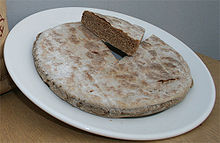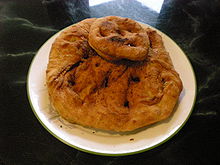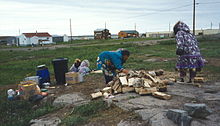- Bannock (food)
-
 Traditional beremeal bannock, as made in Orkney, Scotland. The separated sector is a scone.
Traditional beremeal bannock, as made in Orkney, Scotland. The separated sector is a scone.
Bannock is a variety of flat quick bread. The word can also be applied to any large, round article baked or cooked from grain. When a round bannock is cut into wedges, the wedges are often called scones. But in Scotland, the words bannock and scone are often used interchangeably.[1][2]
Contents
Scottish
"Bannock" is an Scots word of Celtic origin. The Oxford English Dictionary states the term stems from panicium, a Latin word for "baked dough", or from panis, meaning bread. Its first cited use was in 1000, and its first cited definition in 1562. Its historic use was primarily in Ireland, Scotland and Northern England.[3] The Scottish poet Robert Burns mentions the bannock in his Epistle to James Tennant of Glenconner, in reference to Alexander Tennant.[4]
The original bannocks were heavy, flat cakes of unleavened barley or oatmeal dough formed into a round or oval shape, then cooked on a griddle (or girdle, in the Scots language). In northern Scotland, before the 19th century, bannocks were cooked on a Bannock Stane (Scots for stone), a large, flat, rounded piece of sandstone, placed directly onto a fire, then used as a cooking surface.[5] Most modern bannocks are made with baking powder or baking soda as a leavening agent, giving them a light and airy texture.[1][2][6]
Bannock varieties can be named or differentiated according to various characteristics: the flour or meal from which they are made, whether they are leavened or not, whether they have certain special ingredients, how they are baked or cooked, and the names of rituals or festivals in which they are used. Historically, specially made bannocks were used in rituals marking the changing of the Gaelic seasons: St. Bride's bannock for spring (February 1), Béaltaine bannock for summer (May 1), Lughnasadh or Lammas bannock for autumn harvests (August 1), and Samhain bannock for winter (end of October). Other special Scottish and Gaelic bannocks include beremeal bannock, bride's bannock, cod liver bannock, cryin' bannock, fallaid bannock, fife bannock, Hogmanay bannock, Marymas bannock, mashlum bannock, Michaelmas bannock, pease bannock, Pitcaithly bannock, salt bannock, sautie bannock, Silverweed bannock, St. Columba's bannock, teethin' bannock, Yetholm bannock, and Yule bannock.[1]
A well-known Scottish bannock is the Selkirk Bannock, a spongy, buttery variety, sometimes compared to a fruitcake,[7] made from wheat flour and containing a very large quantity of raisins. The first known maker of this variety was a baker named Robbie Douglas, who opened his shop in Selkirk in 1859. When Queen Victoria visited Sir Walter Scott's granddaughter at Abbotsford she is said to have taken her tea with a slice of Selkirk Bannock—ensuring that its reputation was enshrined forever.[8] Today, Selkirk Bannocks are popular throughout Great Britain, and can be found at most large supermarkets.[2]
Indigenous North Americans
Inuit bannock
 An Inuk woman preparing bannock
An Inuk woman preparing bannock
Bannock, also known as frybread, skaan/scone or Indian bread,[9] is found throughout North American native cuisine, including that of the Inuit/Eskimo of Canada and Alaska, other Alaska Natives, the First Nations of the rest of Canada, the Native Americans in the United States and the Métis.[9][10]
As made by indigenous North Americans, bannock is generally prepared with white or whole wheat flour, baking powder and water, which are combined and kneaded (possibly with spices, dried fruits or other flavouring agents added) then fried in rendered fat, vegetable oil, or shortening, baked in an oven or cooked on a stick.[10]
A type of bannock, using available resources, such as flour made from roots, tree sap and leavening agents, may have been produced by indigenous North Americans prior to contact with outsiders.[10] Some sources indicate that bannock was unknown in North America until the 1860s when it was created by the Navajo who were incarcerated at Fort Sumner,[11] while others indicate that it came from a Scottish source.[9]
Tibetan
Main article: Balep korkunBalep korkun is a Tibetan bannock made from barley flour and cooked on a frying pan.
References
- ^ a b c "Bannock". Practically Edible: The Web's Biggest Food Encyclopaedia. http://www.practicallyedible.com/edible.nsf/pages/bannock. Retrieved 2008-10-18.
- ^ a b c Ingram, Christine; Jennie Shapter (2003). BREAD: the breads of the world and how to bake them at home. (Originally published as The World Encyclopedia of Bread and Bread Making.) London: Hermes House. p. 54. ISBN 0-681-87922-X. http://www.amazon.com/Bread-Breads-World-Bake-Them/dp/068187922X.
- ^ Simpson, John; Edward Weiner, Eds. (1989). Oxford English Dictionary, Second Edition. Clarendon Press. http://www.oed.com/.
- ^ Burns, Robert. "Epistle To James Tennant Of Glenconner". The Complete Works of Robert Burns. Robert Burns Country. http://www.robertburns.org/works/255.shtml. Retrieved 2008-10-19.
- ^ Feilden, Rosemary (1999). "Bannock Stane at Aberdeen University's Virtual Museum". Aberdeen University. https://aberdeen.ac.uk/virtualmuseum/pictures_show2.php?prefix=ABDUA&num=16317. Retrieved 2009-11-12.
- ^ Clayton, Bernard Jr. (2003). Bernard Clayton's New Complete Book of Breads. New York: Simon & Schuster. p. 555. ISBN 0743234723.
- ^ Nibble on a Selkirk Bannock
- ^ "Selkirk Bannock". Practically Edible: The Web's Biggest Food Encyclopaedia. http://www.practicallyedible.com/edible.nsf/encyclopaedia!openframeset&frame=Right&Src=/edible.nsf/pages/selkirkbannock!opendocument. Retrieved 2008-10-18.
- ^ a b c Oswalt, Wendell H. (2001). This Land Was Theirs: A Study of Native Americans. Greenwood Publishing Group. ISBN 978-0195175141. http://books.google.ca/books?id=fouevV9ZOn0C&pg=PA119&lpg=PA119&dq=bannock+frybread+history+north+america&source=web&ots=Iixz_35LLb&sig=7jO96hIeUKAbAKujMEG5z3NkJSo&hl=en&sa=X&oi=book_result&resnum=10&ct=result#PPA120,M1. Retrieved 2008-10-18.
- ^ a b c Michael D. Blackstock. "Bannock Awareness". Government of British Columbia. http://www.for.gov.bc.ca/rsi/fnb/FNB.htm. Retrieved 2008-10-18.
- ^ Berzok, Linda Murray (2005). American Indian Food. Oxford University Press. ISBN 978-0313329890. http://books.google.ca/books?id=B_y0ekzJvwQC&pg=PA36&lpg=PA36&dq=fry+bread:+the+making+of+an+icon&source=web&ots=e7MjleODsG&sig=87ptWvH4Nr6GWp8fenpsNGnZVN8&hl=en&sa=X&oi=book_result&resnum=2&ct=result. Retrieved 2008-10-18.
External links
 Chisholm, Hugh, ed (1911). "Bannock (cake)". Encyclopædia Britannica (11th ed.). Cambridge University Press.
Chisholm, Hugh, ed (1911). "Bannock (cake)". Encyclopædia Britannica (11th ed.). Cambridge University Press.
American breads Amish Friendship Bread · Anadama bread · Banana bread · Bannock (food) · Beaten biscuit · Biscuit (bread) · Bulkie roll · Cornbread · Cuban bread · Frybread · Hot water corn bread · Hushpuppy · Kaiser roll · Muffin · Muffin (English) · Muffuletta · Parker House roll · Pepperoni roll · Popover · Pullman loaf · Shawnee cake · Sloosh · Texas toast
British breads Bannock • Bara brith • Barley bread • Bath bun • Bread roll • Buttery • Chelsea bun • Cockle bread • Colston bun • Cottage loaf • Crumpet • Dripping cake • Farl • Fried bread • Griddle scone • Hot cross bun • Iced bun • Lady Arundel's Manchet • Lardy cake • London bun • Manchet • Muffin • Pan loaf • Plain loaf • Potato scone • Saffron bun • Sally Lunn bun • Scone • Scuffler • Singing hinny • Stottie cake
Pancakes Types Æbleskiver • Appam • Bánh cuốn • Bánh xèo • Bannock • Blintz • Boûkète • Boxty • Cachapa • Chalboribbang • Chapati • Chataamari • Chinese pancake • Crempog • Crêpe • Dosa • Dutch baby pancake • Eggette • Farinata • Flädle • Fläskpannkaka • Funkaso • Galette • Hirayachi • Hortobágyi palacsinta • Injera • Jeon • Jonnycake • Khanom bueang • Memela • Memiljeon • Mofletta • Murtabak • Nalesniki • Oatcake • Okonomiyaki • Palatschinke • Pannekoek • Pathiri • Pesarattu • Ploye • Poffertjes • Potato pancake • Quarkkäulchen • Rava dosa • Roti prata • Sel roti • Socca • Spring pancake • Suncake • Serabi • Thalipeeth • Tlacoyo • Touton • UttapamBrands Categories:- American breads
- British breads
- Native American cuisine
- Scottish cuisine
- Pancakes
- Quick breads
- First Nations culture
- Inuit cuisine
- Alaskan cuisine
- Cuisine of the Western United States
- Aboriginal cuisine in Canada
- Canadian cuisine
Wikimedia Foundation. 2010.


